Compliance AI has built its reputation as a specialist regtech platform designed to help financial institutions, fintechs, and other regulated businesses keep up with an ever-changing web of laws, rules, and guidance.
From automated regulatory change tracking to AI-powered obligation extraction, the platform aims to make compliance teams faster, more accurate, and less reactive.
But while its capabilities are clear, its pricing is not, as Compliance AI doesn’t publish a rate card or off-the-shelf plans.
For buyers, that means understanding potential costs can be tricky without engaging directly with sales.
In this guide, I’ll unpack what’s known about Compliance AI’s pricing model, the factors that influence total cost, and how it compares to more transparent GRC solutions on the market.
TL;DR
- Compliance AI is a niche regtech platform tailored for financial institutions, offering robust regulatory change monitoring, AI-powered obligation extraction, and workflow automation - but with no free plan, no published pricing, and a narrow industry scope.
- SmartSuite delivers a unified, industry-agnostic GRC platform with compliance, risk, audit, privacy, vendor, and incident management in one place, plus real-time collaboration, customization, and ready-made templates.
- Pricing transparency is a key differentiator: SmartSuite offers a free forever plan, paid tiers starting at $12/user/month, and a 14-day free trial, while Compliance AIrequires a custom quote and offers trial access only on request.
- For organizations seeking flexibility, scalability, and broader use cases, SmartSuite provides enterprise-grade GRC capabilities at accessible, predictable pricing.
Let’s begin!
Does Compliance AI offer a free plan or free trial?
In the GRC and regtech world, free plans and trials aren’t just something that’s nice to have.
They’re often the best way for busy compliance teams to see if a tool really fits their workflows before committing - and paying a hefty sum.
A freemium model lets smaller teams get started with core features at no cost, while a trial period gives larger organizations the chance to pressure-test functionality in a real-world setting.
Compliance AI takes a more traditional enterprise approach.
You can request access to try the platform, but the company doesn’t publicly state how long that trial period lasts or what’s included.
Instead, the process typically starts with filling out a contact form and waiting for their team to get back to you.
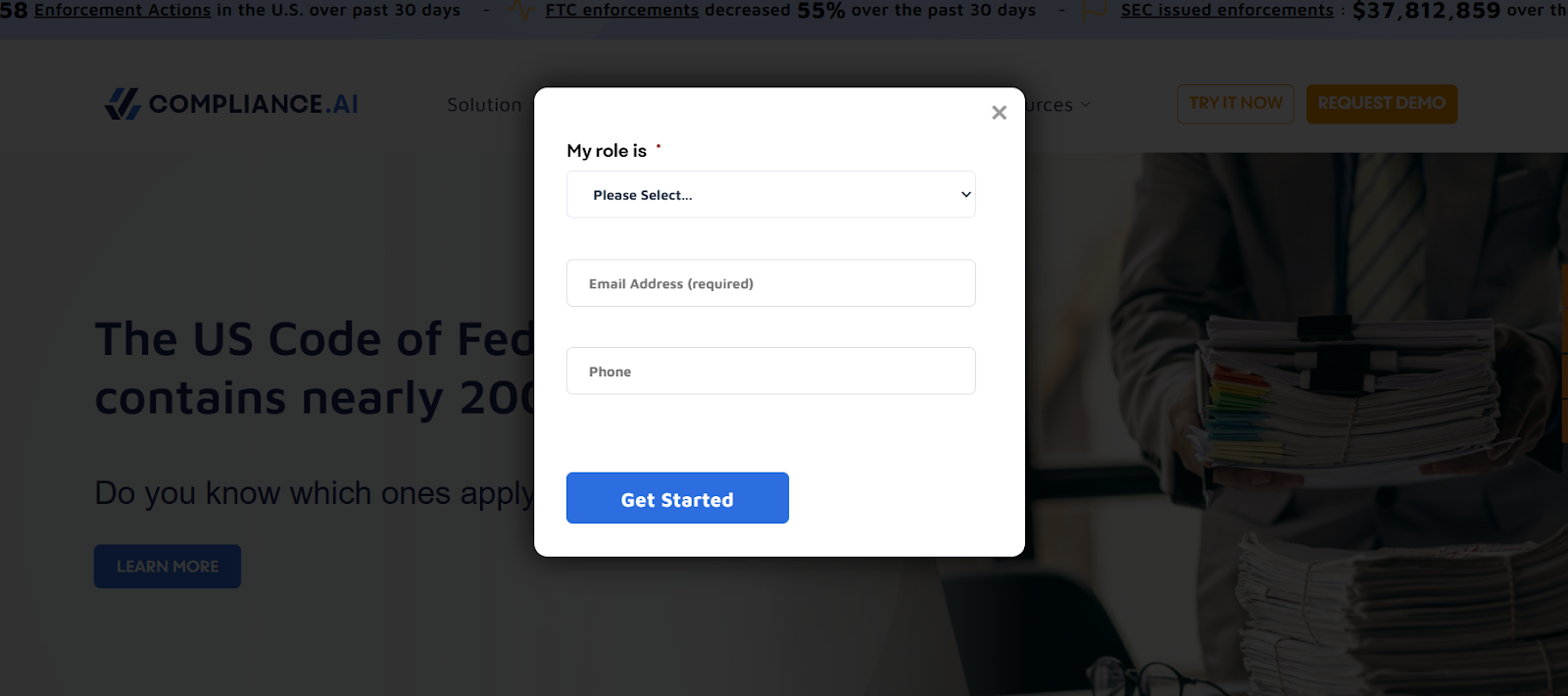
Source: Compliance AI.
If you’d rather not jump straight into a trial, you can also book a live demo to see the platform in action.
This is helpful for understanding how features like regulatory change tracking, dashboards, and task automation work together.
What you won’t find, however, is a true free plan.
Compliance AI doesn’t offer ongoing, no-cost access, which means budget-conscious teams may need to look at alternatives with more flexible entry points.
Compliance AI pricing plans
Compliance.ai doesn’t publish fixed pricing or ready-made tiers, instead offering a custom-quote model that’s tailored to each client.
How much does Compliance AI actually cost?
Without more official information, it’s impossible to give a definitive answer to this.
However, looking at similar regtech platforms, such as VComply ($1,000/month for a professional suite) and Regology ($1,250 per user/month for Pro tier), Compliance AI likely sits in a comparable mid-to-high enterprise SaaS range.
The final cost, though, for other tools, typically depends on factors like:
- User count.
- Jurisdictions covered.
- Optional add-ons like global regulatory content or enforcement tracking.
For buyers, the takeaway is clear: budget planning for Compliance AI requires direct engagement with sales.
Does Compliance AI provide good value for money?
Because Compliance AI’s pricing is entirely custom and not disclosed publicly, judging value for money comes down to looking at its industry focus, feature set, and the depth of its offering.
The first thing you should be aware of is that this is not a one-size-fits-all GRC tool.
Compliance AI is a niche regtech platform built almost exclusively for financial institutions.
Its feature set is tailored to help banks, credit unions, fintechs, and other regulated players reduce compliance risk and keep pace with changing regulations, with key capabilities such as:
- Modern Command Center with configurable, personalized dashboards that highlight potential compliance issues enterprise-wide, helping teams avoid audit findings, enforcement actions, and fines.
- Proactive regulatory monitoring from any source, filtered so specialists see only the updates relevant to their agencies, topics, and requirements.
- Expert-in-the-Loop methodology that ensures actual human oversight of all machine-driven processes that identify obligations and pinpoint their impact on controls, policies, and processes.
- Repeatable, auditable change management workflows that standardize processes, automate compliance tasks, and produce secure, third-party-certified reports for examiners.
For organizations in that space, such specialization can mean a faster path to compliance readiness and reduced manual workload.
But for companies outside financial services, the narrow scope may limit its usefulness, especially given there’s no free plan to test its long-term fit.
Another consideration is the lack of verified user reviews on major software rating sites.
While Compliance AI showcases positive testimonials on its own website, the absence of independent feedback makes it harder to benchmark real-world ROI against similar tools.
In short, Compliance AI likely delivers strong value for its target market.
But without more transparent pricing or broader peer feedback, most teams will need to rely on a demo or pilot project to assess whether the cost aligns with the benefit for their organization.
Looking for a Compliance AI alternative?
While Compliance AI is a powerful financial and regulatory compliance software, it’s not a good fit for everyone, as we’ve seen so far.
Luckily, there are lots of Compliance AI alternatives that offer more flexibility and use cases for you to choose from.
If your organization needs robust compliance management within a platform that’s more versatile, transparent, and adaptable than Compliance.ai, then SmartSuite is the clear front-runner.

While Compliance.ai is purpose-built for the financial sector, SmartSuite offers a flexible, no-code platform that serves a much broader range of industries without sacrificing depth in regulatory tracking, audit readiness, or risk oversight.
With SmartSuite, you get an all-in-one work management solution that centralizes compliance processes alongside your other business-critical workflows, eliminating the need for fragmented tools.
Its intuitive interface, real-time collaboration, and powerful automation features help teams of any size stay ahead of regulatory requirements, streamline audits, and reduce risk exposure, all while benefiting from transparent, scalable pricing.
In the next section, I’ll break down SmartSuite’s key compliance features and show why it’s the go-to alternative for teams that need both enterprise-grade compliance capabilities and the agility to adapt to any operational need.
1. One-stop shop for GRC
SmartSuite brings every aspect of governance, risk, and compliance together in one intuitive, enterprise-ready platform.
Instead of juggling siloed tools or trying to force-fit a financial-sector-only solution like Compliance AI, SmartSuite gives you interconnected GRC practice areas that work seamlessly together, whether you’re in banking, healthcare, manufacturing, or another regulated industry.

From novice compliance coordinators to experienced risk officers, SmartSuite’s best-practice templates and flexible design make it easy to manage your entire GRC program without sacrificing sophistication.
Here are some of the features included in SmartSuite’s GRC module:
- Centralized compliance management - Track regulatory requirements, manage policies, and monitor audits in one workspace. Cover everything from contract and vendor management to business continuity and privacy compliance.
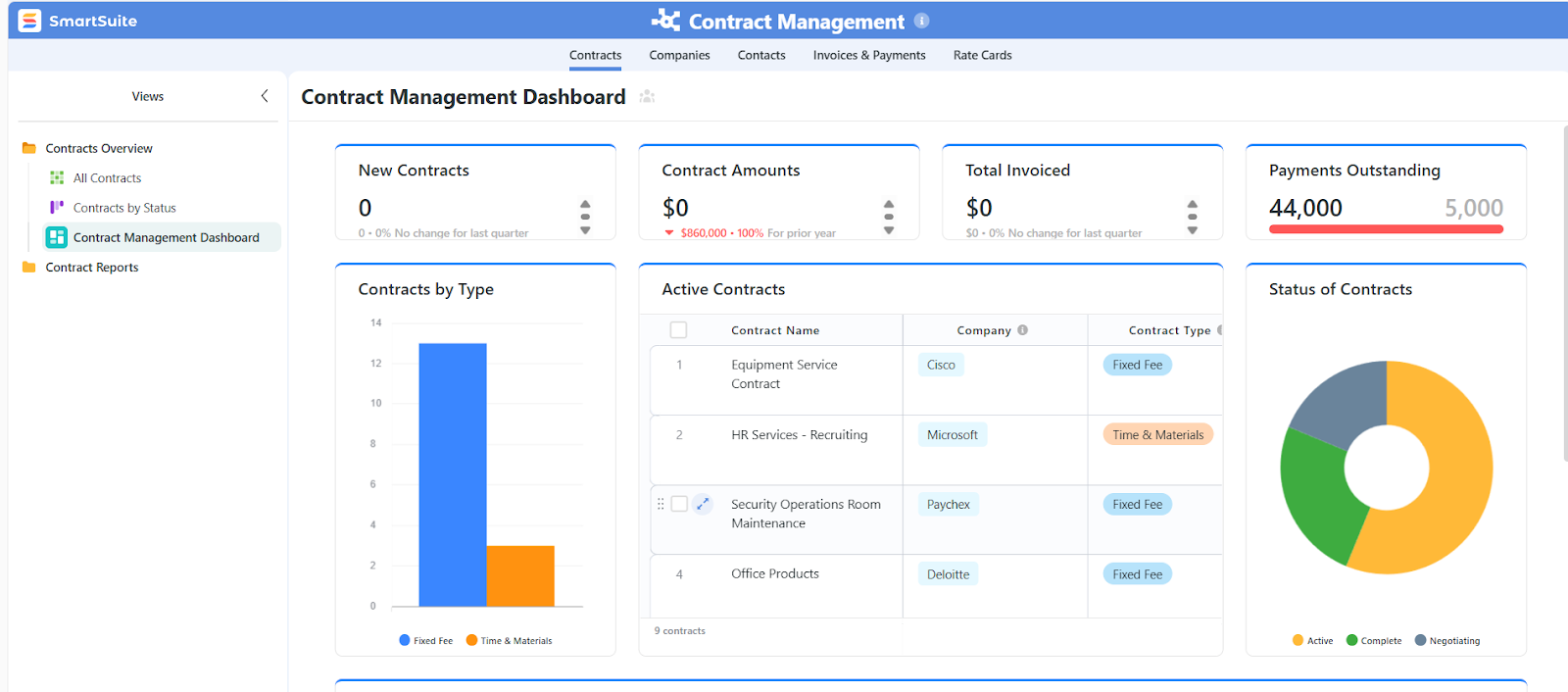
- Risk & audit tracking - Maintain a centralized risk register to identify, score, and prioritize threats. Map controls to risks, log audits with full traceability, automatically assign critical tasks, and measure effectiveness with risk indicators and roll-up reports.
- Automation & workflow builder - Automate repeatable processes like policy approvals, incident escalations, and periodic assessments. SmartSuite’s visual automation builder makes it easy to ensure consistency and eliminate human error.
- Reporting & dashboards - Build executive-level dashboards with powerful charting and metrics widgets. Drill down into specific compliance areas, or keep a high-level view of your organization’s overall risk posture.

- Threat management - Bring all incident response and threat mitigation efforts into one place. Connect incidents to related assets and organizational data to provide essential context during investigations, and automate escalations so critical issues are addressed quickly and efficiently.
- Privacy management - Simplify adherence to data protection regulations such as GDPR and CCPA. Equip your teams with efficient workflows to manage privacy requirements while reinforcing customer trust through robust, industry-leading data handling practices.
- Vendor management - Consolidate third-party information, manage contracts, track performance, and strengthen vendor relationships across the supply chain.
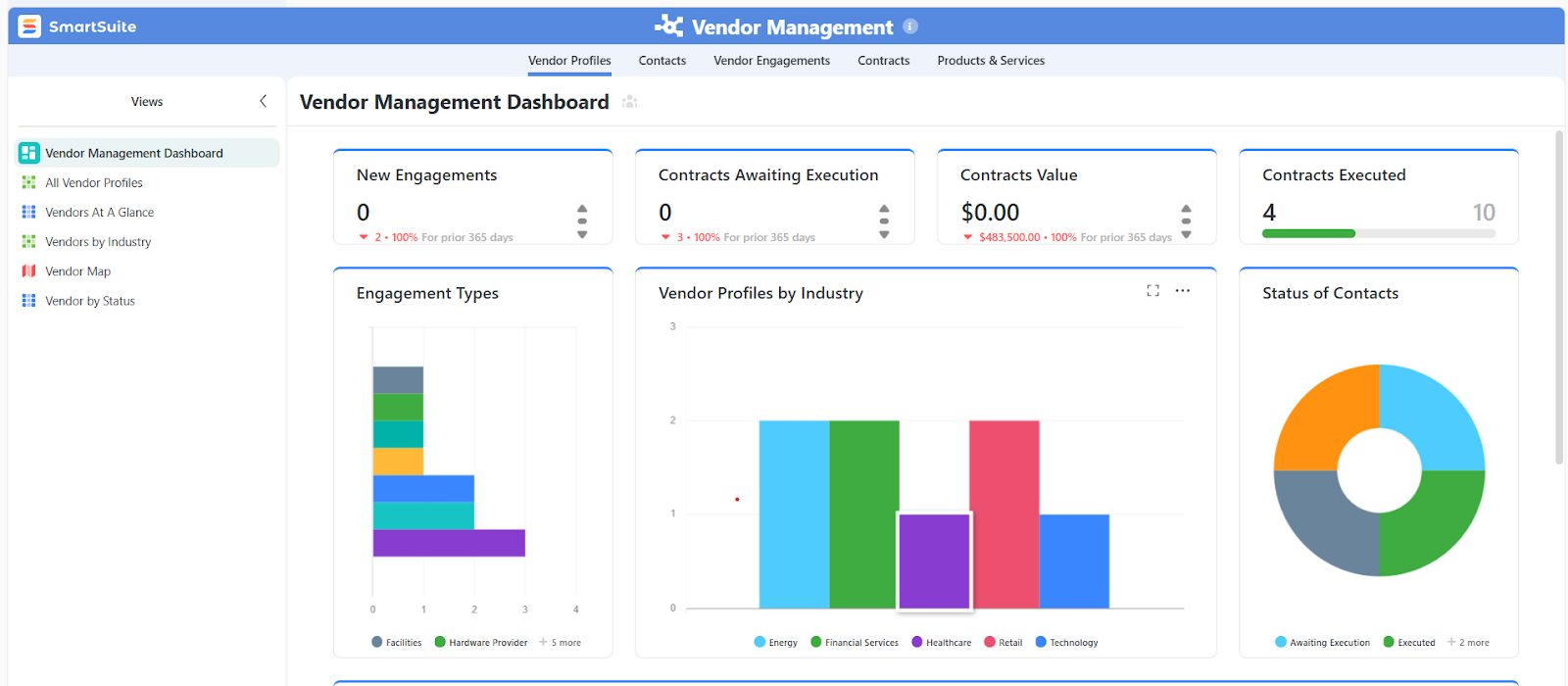
By uniting these capabilities under one roof, SmartSuite not only improves compliance outcomes but also streamlines collaboration between compliance, risk, audit, and operational teams, helping organizations move faster, stay aligned, and reduce the cost of staying compliant.
2. Real-time team collaboration
In governance, risk, and compliance, coordination between teams isn’t optional - it’s mission critical.
Regulatory updates, emerging risks, and audit findings often require rapid, multi-stakeholder input, and delays can mean missed deadlines or heightened exposure. \
SmartSuite eliminates those bottlenecks by enabling collaboration directly within the workflows and records where the work is happening, so conversations and actions stay connected.
Here are some of SmartSuite’s collaborative features:
- Contextual discussions - Start and continue conversations inside compliance records, whether you’re reviewing a new policy, responding to a risk event, or assessing a third-party vendor. Built-in comments, @mentions, and instant notifications ensure the right people are looped in at the right time.
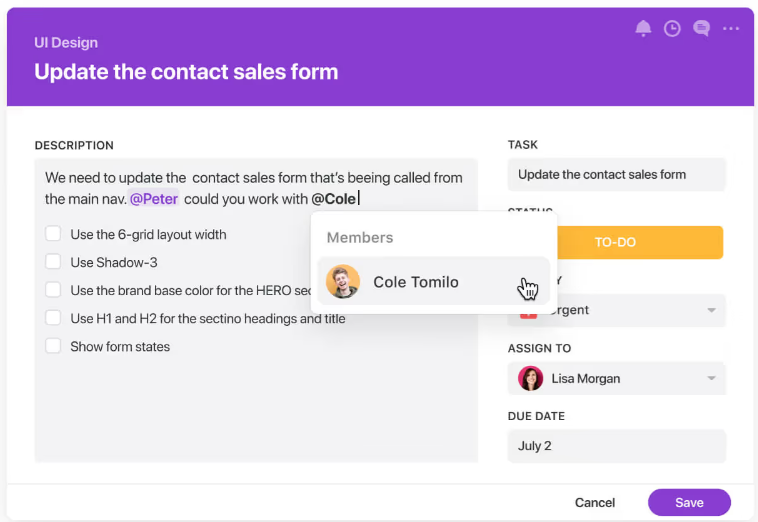
- Integrated email communication - Send and receive emails from within SmartSuite records, complete with pre-built templates for consistent, on-brand responses to regulators, auditors, or internal stakeholders.
- Real-time editing - Multiple team members can update the same record simultaneously, seeing changes as they happen. No more waiting for a colleague to “finish” editing before you can add your input.
- Audit-ready activity histories - Track every edit, comment, and decision in a time-stamped history. Not only does this maintain accountability, it also provides ready-made evidence for audits and regulatory reviews.
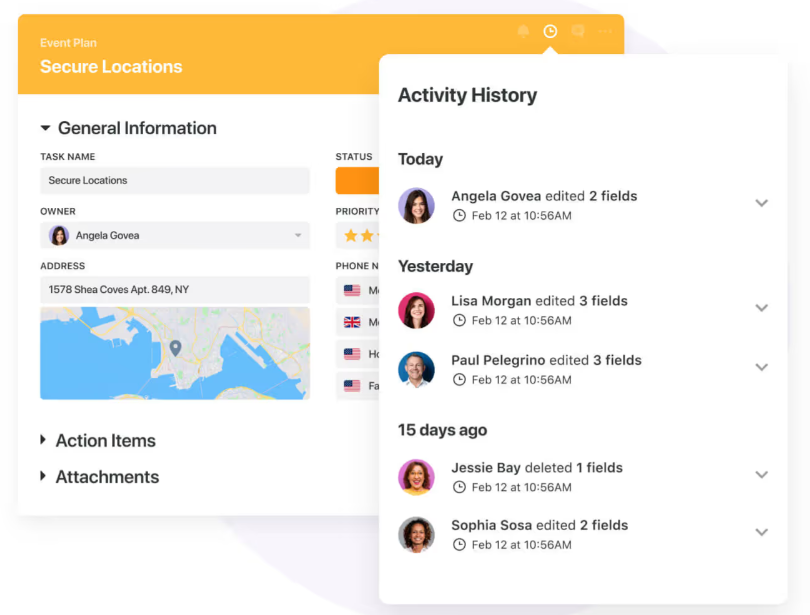
- Access controls for sensitive data - Assign role-based permissions to keep confidential information protected while ensuring decision-makers and response teams can act without delay.
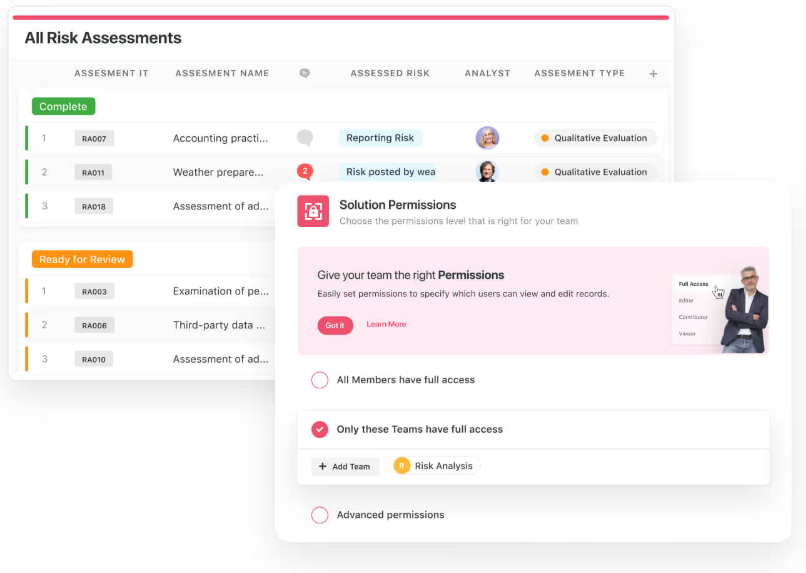
- Morale-boosting visibility - Celebrate milestones and progress during lengthy compliance cycles, reinforcing a culture of engagement and shared responsibility.
By embedding collaboration into the heart of GRC processes, SmartSuite helps compliance, risk, and audit teams move faster, make better decisions, and stay fully aligned without the inefficiencies of scattered tools or disconnected conversations.
3. Ready-made, fully customizable templates
Launching or improving a GRC program doesn’t have to mean starting from scratch.
SmartSuite comes with a library of ready-to-use, fully customizable solution templates designed to address core governance, risk, and compliance workflows right out of the box.
Each template is built on industry best practices, so teams can get up and running fast, and then adapt the details to fit their specific processes, regulatory requirements, and organizational culture.

Popular GRC templates include:
- Policy Management - Centralize authoring, review, and publication of policies, ensuring they align with business goals and regulatory mandates. Track revisions, assign ownership, and control distribution across the organization.
- Incident Management - Capture, assign, and resolve compliance incidents with full audit trails, automated escalations, and linked assets for complete investigative context.
- Third-Party Risk Management - Consolidate vendor information, automate periodic assessments, and track contractual obligations to reduce supplier-related risk.
- Risk Management - Identify, assess, and prioritize risks by likelihood and impact. Assign owners, define mitigation actions, and track residual risk over time.
- Business Continuity Plans - Design, test, and maintain recovery procedures to ensure operational resilience during disruptions.
- Regulatory Change Management - Monitor and respond to evolving regulations with workflows that keep policies, controls, and documentation aligned.
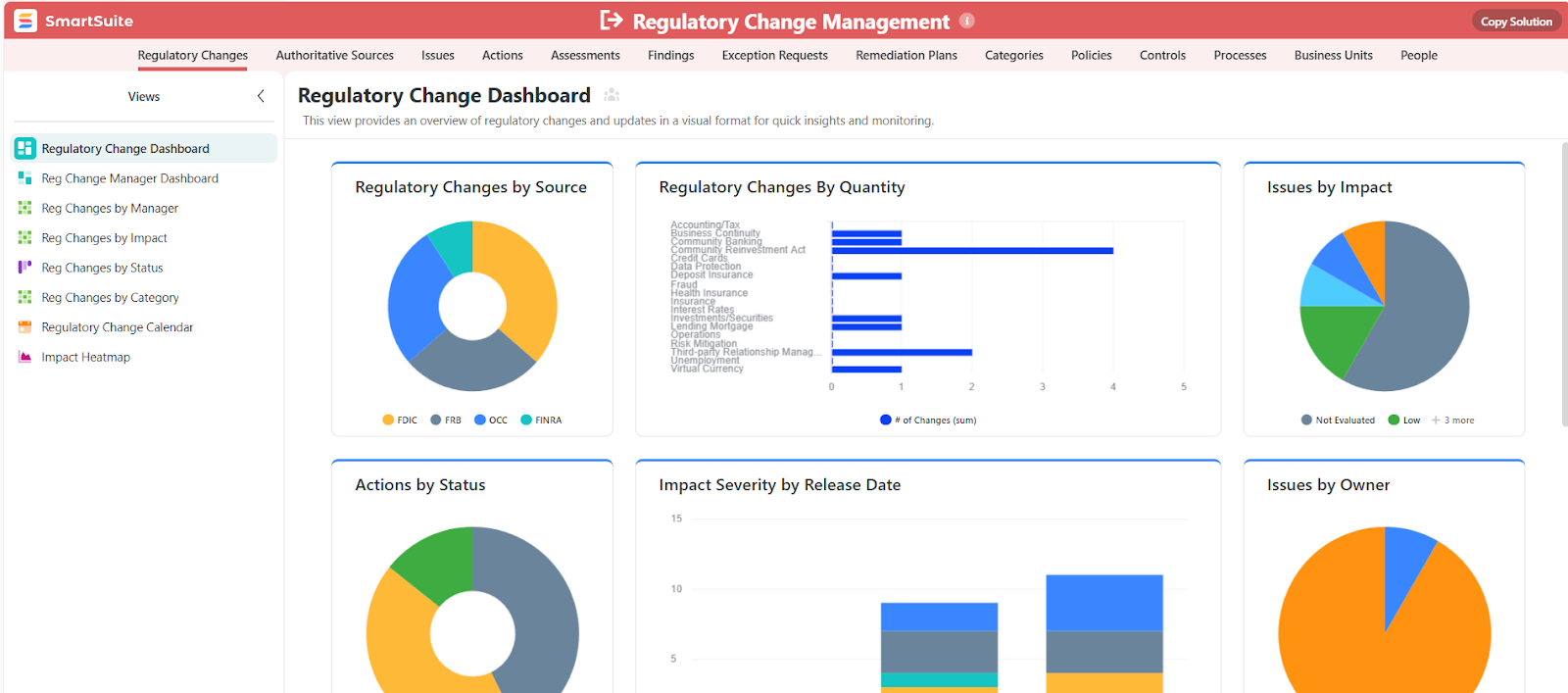
Every template can be reconfigured in minutes by adding or removing fields, changing workflows, or integrating with existing systems, so it works exactly the way your team does.
This flexibility means you can jumpstart compliance processes today while still having the freedom to refine and evolve them as regulations, risks, and priorities change.
Explore this template firsthand - click, edit, and interact just like your team would.
4. Customization & flexibility
Industry, jurisdiction, regulatory scope, and internal processes all shape how governance, risk, and compliance programs need to run.
SmartSuite is built to adapt, so instead of forcing your team into rigid, pre-set workflows, you can design the platform around your processes, risk models, and reporting needs.
Here’s how:
- Tailored workflows & fields - With over 40 configurable field types, you can capture exactly the information you need, whether that’s risk likelihood scores, regulator contact details, policy review deadlines, or vendor due diligence notes.
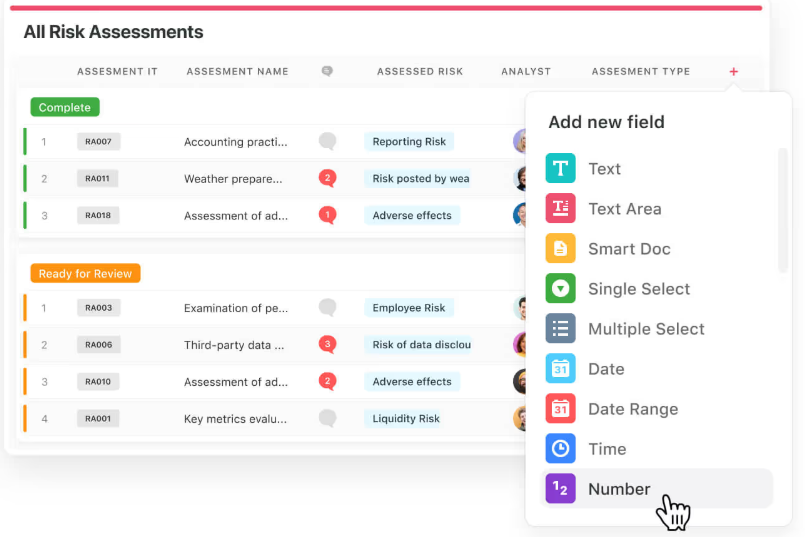
- Custom risk calculations - Build your own scoring models and KPIs to evaluate risk exposure, compliance posture, or audit readiness. Calculate composite scores and monitor key indicators to spot trends before they escalate into issues.
- Personalized reports - Create dashboards for executives, compliance officers, or auditors, each with the specific metrics and visualizations they need. Filter, sort, and drill down into data for quick, targeted insights.
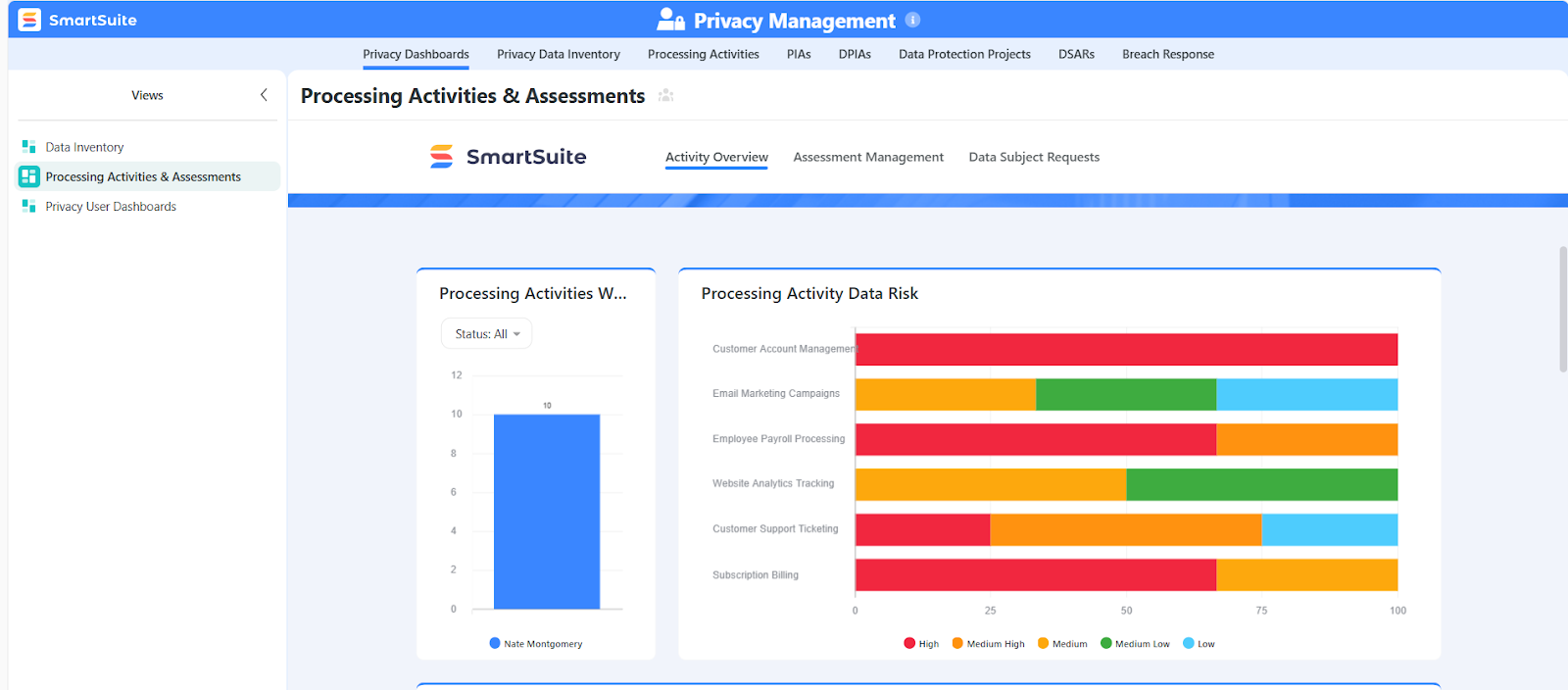
- Seamless integrations - Connect SmartSuite to your existing systems, from document repositories to ERP or GRC solutions, via native integrations, a Zapier connector, or the full REST API. This ensures compliance data is centralized without duplicating effort.
This means that whether you’re managing a bank’s regulatory change program, a hospital’s privacy compliance, or a manufacturer’s supply chain risk, SmartSuite can be configured to match your operational realities, providing you with a single source of truth across all GRC activities.
How does SmartSuite’s pricing compare to Compliance AI’s?
One of the biggest differences between SmartSuite and Compliance.ai is pricing transparency.
Compliance.ai operates on a custom-quote model, meaning you’ll need to speak with sales to get any numbers.
Moreover, costs can probably vary widely depending on your industry, number of users, jurisdictions monitored, and integration needs.
It also doesn’t offer a free plan, so there’s no way to explore the platform long-term without committing financially.
SmartSuite, by contrast, publishes its plans openly and gives teams multiple entry points:
- Free Forever: Ideal for small teams exploring the platform, with access to templates, dynamic dashboards, team collaboration features, and 100 monthly automations.
- Team: $12/user/month, includes everything in Free, plus unlimited users, Gantt charts, and 5,000 automation runs.
- Professional: $30/user/month, adds two-factor authentication, Gmail & Outlook integrations, AI features, and more automation capacity.
- Enterprise: $45/user/month, includes everything in Professional, plus audit logs, data loss prevention, and 50,000 monthly API calls.
- Signature: Custom pricing tailored to your organization’s needs with no predefined limits.

The first three paid plans come with a 14-day free trial (no credit card required), making it easy to test the platform before making a decision - something Compliance AI simply doesn’t offer.
How is SmartSuite different from Compliance AI?
While both SmartSuite and Compliance AI help organizations navigate complex regulatory environments, the way they approach GRC is very different, and it shows very clearly in several areas:
- Industry focus:
- Compliance AI is a niche regtech platform built almost exclusively for financial institutions, credit unions, and fintechs. Its features are highly specialized for the financial sector.
- SmartSuite takes an industry-agnostic approach. It’s designed to support GRC programs in finance, healthcare, manufacturing, technology, and beyond, offering the same depth of compliance, risk, and audit management without locking you into a single sector.
- Scope of capabilities:
- Compliance AI focuses heavily on regulatory change management and monitoring, with structured dashboards, personalized alerts, and repeatable workflows. It’s powerful in its lane, but lacks the broader operational and cross-departmental capabilities many organizations need.
- SmartSuite unites compliance, risk, audit, privacy, vendor management, business continuity, and incident response in one interconnected platform, alongside other work management capabilities, eliminating the need for multiple siloed tools.
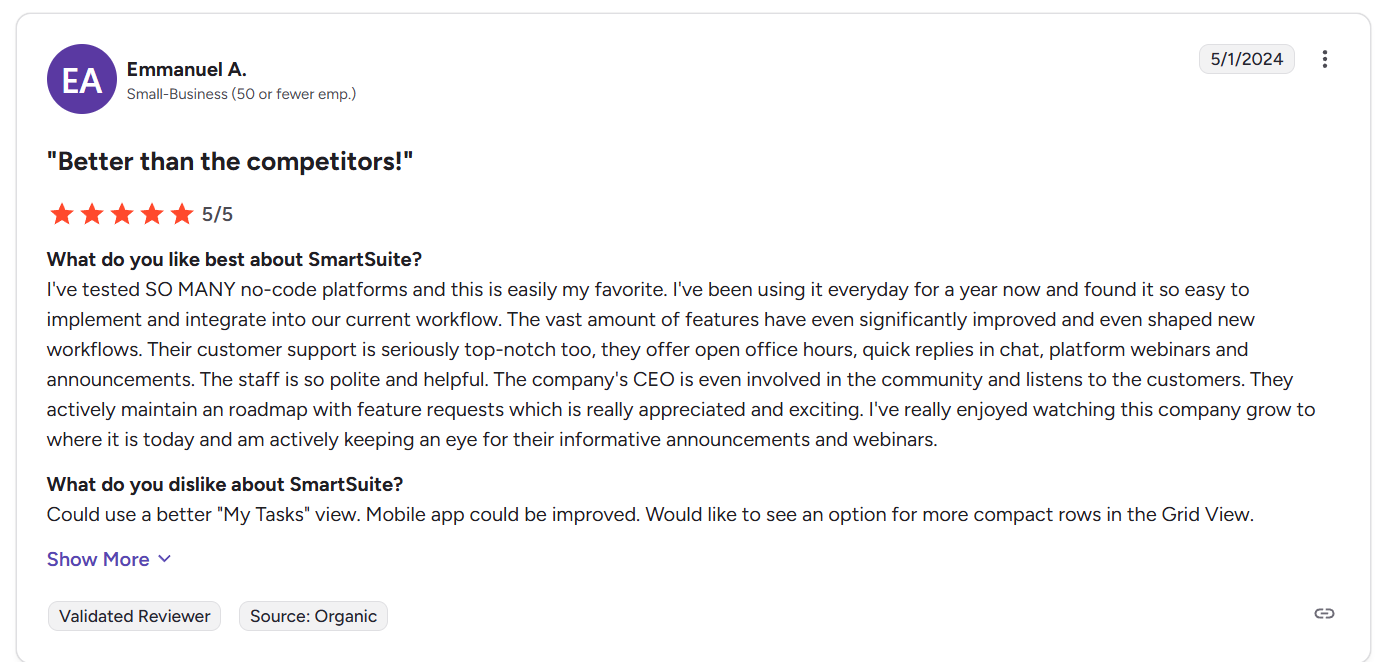
- Templates & setup speed:
- Compliance AI is feature-rich but requires a custom onboarding process to get started.
- SmartSuite offers ready-made, fully customizable templates for core GRC workflows, so teams can launch faster and still adapt the system over time.
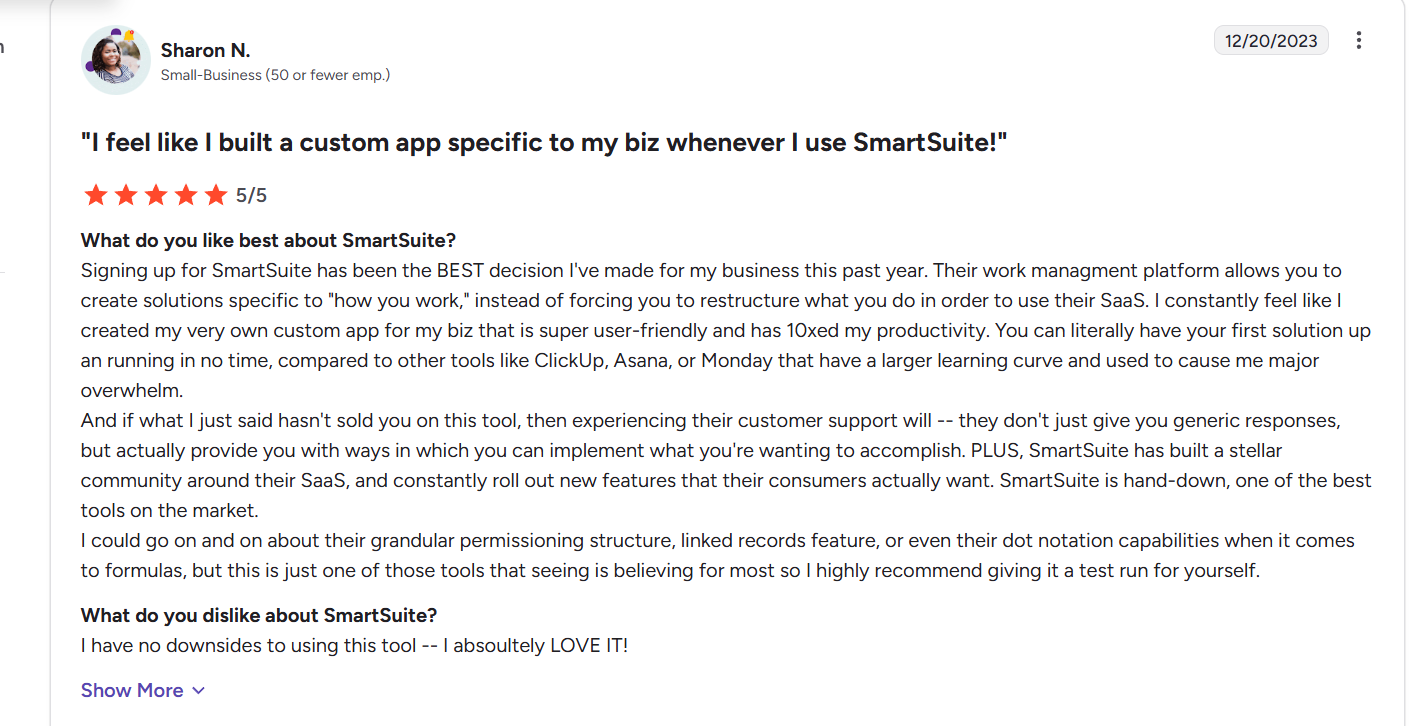
- Pricing & accessibility:
- Compliance AI uses a custom-quote pricing model, doesn’t publish rates, and offers no free plan. Trial access is available on request but without public details on duration or scope.
- SmartSuite has a transparent, scalable pricing structure, including a free forever plan for smaller teams, and a 14-day free trial for its first three paid tiers. This allows organizations to test-drive the platform before committing budget.
In short, Compliance AI is best suited for financial institutions needing highly specialized regulatory change monitoring, while SmartSuite delivers enterprise-grade compliance capabilities with broader industry coverage, greater flexibility, and far more accessible pricing.
Final thoughts: Choosing the right GRC platform for your organization
Compliance AI is a proven regtech solution for financial institutions that need deep regulatory change monitoring and sector-specific features.
But its narrow industry focus, opaque pricing, and lack of a free plan make it harder for many organizations to evaluate and adopt fully.
SmartSuite offers a different path, one that combines enterprise-grade GRC capabilities with industry-agnostic flexibility, transparent pricing, and rapid deployment.
Whether you’re in finance, healthcare, manufacturing, or tech, you can manage compliance, risk, audits, vendors, incidents, and more in a single, connected platform, while also running your other operational workflows in the same place.
With SmartSuite, you get:
- A free forever plan to explore core features at no cost.
- Scalable paid plans starting at just $12/user/month.
- Ready-made, fully customizable GRC templates to get started fast.
- Real-time collaboration tools to keep compliance teams aligned and audit-ready.
- Flexible integrations and customization to adapt to your exact requirements.
Start your free trial today and see how SmartSuite can streamline your GRC program, reduce risk, and free your team to focus on what matters most.
Read more
- 10 Best Drata Alternatives & Competitors In 2025 [Reviewed] - Discover the top compliance automation tools that rival Drata, with side-by-side comparisons to help you pick the best fit for your security and audit needs.
- ZenGRC Pricing: Is It Worth It In 2025? [Reviewed] - We break down ZenGRC’s pricing, features, and value to see if this GRC platform delivers a strong return on investment in 2025.
- 10 Best Vanta Alternatives & Competitors In 2025 - Explore the leading alternatives to Vanta for SOC 2, ISO 27001, and more, with pros, cons, and pricing insights for each.
- LogicManager Pricing: Is It Worth It In 2025? - Get the full picture on LogicManager’s costs, features, and whether it’s worth the investment for your risk management program.
- Diligent Pricing: Is It Worth It In 2025? [Reviewed] - A deep dive into Diligent’s pricing model and feature set to help you decide if it matches your governance, risk, and compliance needs.
- 10 Best Hyperproof Alternatives For GRC In 2025 - Find the top Hyperproof competitors and see how they stack up on features, pricing, and compliance capabilities.
- Riskonnect Pricing: Is It Worth It In 2025? [Reviewed] - Unpack Riskonnect’s pricing, features, and industry fit to see if it’s the right GRC solution for your organization this year.

Run your entire business on a single platform and stop paying for dozens of apps
- Manage Your Workflows on a Single Platform
- Empower Team Collaboration
- Trusted by 5,000+ Businesses Worldwide















